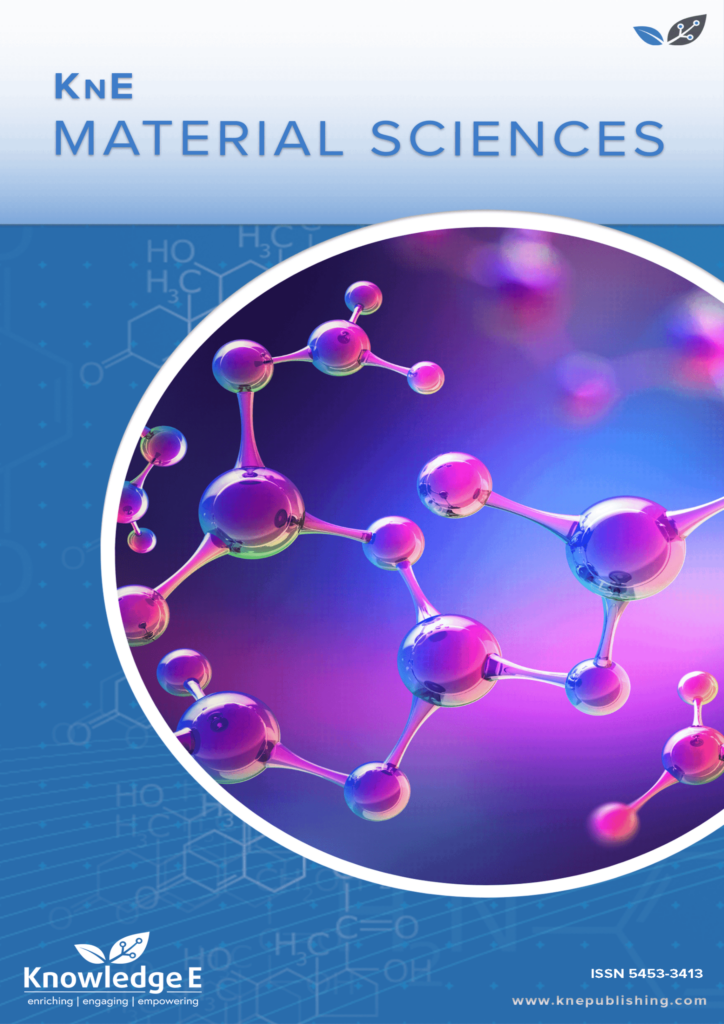
KnE Materials Science
ISSN: 2519-1438
The latest conference proceedings on physical materials, energy materials, electrical materials.
Phytoremediation as a Sustainable Alternative for Organic Matter Removal From Slaughterhouse Wastewater Pretreated by Immediate One-Step Lime Precipitation
Published date: Aug 10 2022
Journal Title: KnE Materials Science
Issue title: 1st International FibEnTech Congress (FibEnTech21) – New Opportunities for Fibrous Materials in the Ecological Transition
Pages: 176–183
Authors:
Abstract:
In this study, slaughterhouse wastewater previously treated by immediate one-step lime precipitation was treated using a vertical flow constructed wetland (VFCW). A VFCW pilot scale planted with Vetiveria zizanioides in light expanded clay aggregates was used to study the influence of the organic load applied (3 to 212 g m−2 d−1) and the bed depth of the VFCW (0.35 and 0.70 m) on the organic matter removal (COD). Two VFCWs operated in parallel under continuous flow, and a hydraulic load of around 80 L m−2 d−1 was used. The results indicated that an increase in the organic load decreased COD removal efficiency. The bed depth of the VFCW had a significant influence on the removal of organic matter, with greater removal at high bed depths. For organic loads applied up to 9.5 g m−2 d−1, COD removal efficiencies of 71.4 ± 4.0% and 85.2 ± 3.4% were observed for lower and higher VFCW bed depth, respectively, which met the requirements for water reuse for irrigation. Throughout the tests, Vetiveria zizanioides did not show signs of toxicity, and its growth was substantial.
Keywords: slaughterhouse wastewater, vertical flow constructed wetlands, Vetiveria zizanioides, organic matter removal, immediate one-step lime precipitation
References:
[1] Boretti A, Rosa L. Reassessing the projections of the world water development report. Clean Water. 2019;2:1–6. https://doi.org/10.1038/s41545-019-0039-9
[2] Norsyahariati N, Daud N, Anijiofor SC. Chicken slaughterhouse wastewater disposal: The challenges ahead. Asian Journal of Agriculture and Biology. 2018; 6 (Special issue):42-45.
[3] Bustillo-Lecompte C, Mehrvar M. ”Slaughterhouse Wastewater: Treatment, Management and Resource Recovery”, in Physico-Chemical Wastewater Treatment and Resource Recovery. London, United Kingdom: IntechOpen, 2017. https://doi.org/10.5772/65499
[4] Mahedi M, Cetin B, Dayioglu AY. Leaching behavior of aluminum, copper, iron and zinc from cement activated fly ash and slag stabilized soils. Waste Management. 2019;95:334–355. https://doi.org/10.1016/j.wasman.2019.06.018
[5] Lin SD. Water and Wastewater Calculations Manual. (McGraw-Hill, Ed.) Chemistry & biodiversity, vol. 1; New York, 2007. http://doi.org/10.1036/0071476245
[6] Martínez-Cruz A, Fernandes A, Ciríaco L et al. Electrochemical oxidation of effluents from food processing industries: A short review and a case-study. Water. 2020;12(3546):1-16. https://doi.org/10.3390/w12123546
[7] Prazeres AR, Fernandes F, Madeira L et al. Treatment of slaughterhouse wastewater by acid precipitation (H2SO4, HCl and HNO3) and oxidation (Ca(ClO)₂, H2O2 and CaO₂). Journal of Environmental Management. 2019;250(109558):1-14. https://doi.org/10.1016/j.jenvman.2019.109558
[8] Hossaini H, Fatehizadeh A, Yousefi N et al. Application of enhanced softening process in slaughterhouse. Indian Journal of Chemical Technology. 2013;20(3):217– 221.
[9] Odong R, Kansiime F, Omara J, Kyambadde J. The potential of four tropical wetland plants for the treatment of abattoir effluent. International Journal of Environmental Technology and Management. 2013;16(3):203-222. https://doi.org/10.1504/IJETM.2013.053640
[10] Lecompte CFB, Mehrvar M, Bolaños EQ. Cost-effectiveness analysis of TOC removal from slaughterhouse wastewater using combined anaerobic-aerobic and UV/H2O2 processes. Journal of Environmental Management. 2014;134:145-152. https://doi.org/10.1016/j.jenvman.2013.12.035
[11] Madeira L, Carvalho F, Teixeira MR, Ribeiro C, Almeida A. Vertical flow constructed wetland as a green solution for low biodegradable and high nitrogen wastewater: A case study of explosives industry. Chemosphere. 2021;272(129871):1- 10. https://doi.org/10.1016/j.chemosphere.2021.129871
[12] Mburu C, Kipkemboi J, Kimwaga R. Impact of substrate type, depth and retention time on organic matter removal in vertical subsurface flow constructed wetland mesocosms for treating slaughterhouse wastewater. Physics and Chemistry of the Earth. 2019;114:102792. https://doi.org/10.1016/J.PCE.2019.07.005
[13] Manh LH, Dung NNX, Am LV, Minh BTL. Treatment of wastewater from slaughterhouse by biodigester and Vetiveria zizanioides. Livestock Research for Rural Development. 2014, volume 26, Article #68. ISSN 0121-3784
[14] Almeida A, Ribeiro C, Carvalho F et al. Phytoremediation potential of Vetiveria zizanioides and Oryza sativa to nitrate and organic substance removal in vertical flow constructed wetland systems. Ecological engineering. 2019;138:19-27. https://doi.org/10.1016/j.ecoleng.2019.06.020
[15] Madeira L, Almeida A, Teixeira RM, Prazeres A, e Carvalho FCH. Immediate one-step lime precipitation and atmospheric carbonation as pre-treatment for low biodegradable and high nitrogen wastewaters: A case study of explosives industry. Journal of Environmental Chemical Engineering. 2020;8(103808):1-10. https://doi.org/10.1016/j.jece.2020.103808
[16] Baird R, Eaton AD, Rice EW, Bridgewater L. Standard methods for the examination of water and wastewater. 23rd ed. American Public Health Association, American Water Works Association, Water Environment Federation; 2017.
[17] Campbell CR, Plank CO. Handbook of reference method for plant analysis. Kalra YP, editor. Boca Raton: CRC Press; 1998.
[18] Miller RO. Handbook of reference method for plant analysis. Kalra YP, editor. Boca Raton (FL): CRC Press; 1998.
[19] Horneck A, Miller RO. Handbook of reference method for plant analysis. Kalra YP, editor. Boca Raton (FL): CRC Press; 1998.
[20] Almeida A, Jozwiakowski K, Kowalczyk-Jusko A et al. Nitrogen removal in vertical flow constructed wetlands: Influence of bed depth and high nitrogen loadings. Environmental Technology. 2018;41(17):2196-2209. https://doi.org/10.1080/09593330.2018.1557749
[21] Decree-Law no. 119/2019, Diário da República, 1.a série, No. 159, 21 de agosto de 2019.